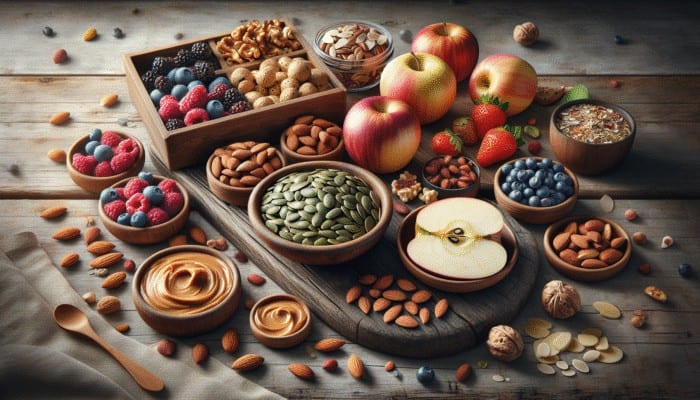Unlocking the Power of High-Fibre Foods for Optimal Digestive Health
How to Make High-Fibre Meals for Digestion: Embarking on the journey to mastering high-fibre meals for enhanced digestion starts with a comprehensive understanding of the fundamental components of dietary fibre. Fibre is a varied and vital element of our diets, playing an indispensable role in promoting robust digestive health and overall wellness. Understanding its significance enables you to appreciate how high-fibre foods contribute to your body’s needs, ensuring you feel your best every day.
Delving into Fiber Types: Exploring Soluble and Insoluble Fiber and Their Impact on Health

Fibre can be categorised into two main types: soluble and insoluble. Soluble fibre dissolves in water, forming a gel-like substance that helps regulate blood sugar levels and lower cholesterol. Foods abundant in soluble fibre include Oats, beans, lentils, apples, and citrus fruits. These foods not only nourish your gut but also promote heart health by helping to eliminate cholesterol from the bloodstream, contributing to a healthier cardiovascular system.
Conversely, insoluble fibre adds bulk to your stool, encouraging regular bowel movements and helping to prevent constipation. This type of fibre is found in whole grains, nuts, seeds, and the skins of many fruits and vegetables, acting as a natural laxative that ensures the digestive system functions effectively. It's crucial to incorporate a balance of both soluble and insoluble fibre into your diet for optimal digestive health and overall wellness.
Embracing a diet rich in high-fibre foods can lead to substantial health improvements beyond digestion. Research indicates that individuals who consume sufficient fibre may enjoy a reduced risk of chronic illnesses, encompassing type 2 diabetes, heart disease, and specific cancers. By grasping these distinctions between fibre types, you empower yourself to make informed dietary choices while creatively incorporating a diverse range of high-fibre foods into your meals.
Essential High-Fibre Food Guide: An Extensive Compilation of Fruits, Vegetables, Grains, and Legumes
Crafting delectable high-fibre meals can be effortless once you know where to source fibre-rich foods. Here’s a detailed list to kickstart your journey:
Fruits: Raspberries, pears, apples, bananas, and oranges are powerhouses of fibre. Berries, particularly, are not only sweet and satisfying but also loaded with antioxidants that combat oxidative stress.
Vegetables Such as Broccoli, Brussels sprouts, carrots, and artichokes serve as excellent sources of fibre. Including a wide variety of vegetables in your meals guarantees a comprehensive array of nutrients while boosting your fibre intake.
Grains: Whole grains are champions when it comes to fibre. Foods like quinoa, brown rice, barley, and whole wheat bread can enhance any dish. They’re not only filling but also versatile, suitable for various cuisines.
Legumes, such as beans, lentils, and chickpeas, are fibre powerhouses. They can be incorporated into soups, salads, or served as main dishes, offering both protein and a significant dose of fibre.
This extensive compilation serves as a foundational resource for creating high-fibre meals that are both nutritious and delicious. Feel free to experiment with these foods, mixing and matching to uncover flavour pairings that delight your taste buds.
Daily Fiber Guidelines: Understanding Recommended Daily Fiber Intake Across Age Groups and Genders
Understanding your daily fibre requirements is crucial in your quest for high-fibre meals that support digestion. The general recommendation suggests that adult women should aim for approximately 25 grams of fibre daily, while adult men should target around 38 grams to support their health needs effectively.
However, these figures can vary depending on age and life stages. Children have different requirements based on their growth stages, typically ranging from 19 grams for younger children to 25 grams for adolescents. As individuals age, their fibre needs may slightly decrease, yet it remains essential to maintain a healthy intake for optimal digestive function.
Women who are pregnant or breastfeeding may also experience increased fibre needs. It is vital to consult healthcare professionals for personalised recommendations if you fall into these categories. Remember, gradually increasing your fibre intake while ensuring adequate hydration is key to preventing digestive discomfort and enhancing overall digestive health.
By aligning your daily fibre intake with these guidelines, you’re making a significant stride towards improved digestive and overall health. This knowledge not only empowers you but also lays the groundwork for crafting high-fibre meals that cater to your unique dietary requirements.
Strategically Planning High-Fibre Meals for Optimal Nutrition

Creating high-fibre meals for digestion involves more than merely adding fibre; it requires meticulous meal planning that is nourishing, satisfying, and enjoyable. Let’s explore some exciting meal ideas that will inspire your culinary adventures.
Breakfast Inspirations: High-Fibre Breakfast Choices Featuring Oatmeal, Whole Grain Toast, and Fibre-Infused Smoothies
Breakfast presents a splendid opportunity to kickstart your day with a robust dose of fibre. Oatmeal, a timeless breakfast favourite, is an excellent choice, providing a warm and hearty beginning to your morning. Topped with fruits such as bananas or berries and a sprinkle of chia seeds, oatmeal can easily surpass the 10-gram fibre threshold, setting a positive tone for the day.
For those who prefer a quicker option, whole-grain toast is a superb alternative. Pair it with avocado, nut butter, or even a poached egg for a satisfying breakfast that keeps you feeling full for longer. Whole grain bread not only contributes fibre but also delivers essential nutrients that energise your morning.
Smoothies provide another dynamic method to incorporate fibre into your breakfast routine. Blend leafy greens, such as spinach or kale, with bananas, berries, and a scoop of flaxseeds or oats for a nutrient-rich beverage. This approach not only boosts fibre content but also enhances the nutritional profile of your breakfast, making it a fantastic option for on-the-go use.
Experimenting with various breakfast combinations can lead to exciting discoveries in taste and texture, ensuring you commence each day feeling energised and satisfied.
Lunch and Dinner Delights: Recipe Ideas for High-Fibre Meals Like Salads, Soups, and Whole Grain Dishes
For lunch and dinner, envision meals that celebrate diversity and flavour while delivering high fibre. Salads serve as an excellent canvas for incorporating fibre-rich ingredients. Start with a base of dark leafy greens, such as kale or spinach, and add a colourful array of vegetables like bell peppers, carrots, and cherry tomatoes. Toss in a handful of chickpeas or black beans for a protein boost and finish with a sprinkle of seeds or nuts for added crunch.
Soups can also be a fantastic way to introduce fibre. A hearty lentil soup, for example, is not only satisfying but also boasts a significant fibre content. Combine lentils with a medley of vegetables, herbs, and spices for a nourishing meal that warms the soul.
Whole grain dishes are versatile and fulfilling. Quinoa bowls topped with roasted vegetables and a protein source, such as grilled chicken or tofu, create a satisfying meal that’s bursting with fibre. The key is to mix various sources of fibre to keep your meals diverse and enjoyable.
With creativity and intention, your lunch and dinner can transform into delicious, high-fibre experiences that nourish your body and tantalise your taste buds.
Snack and Dessert Innovations: Healthy High-Fibre Snack and Dessert Options Featuring Nuts, Seeds, and Fruit-Based Treats

Snacking can often derail your health goals, but it doesn’t have to be that way. A mindful approach to snacking can lead to delightful, high-fibre options. Nuts and seeds are perfect for on-the-go snacking. Almonds, walnuts, and pumpkin seeds are not only rich in fibre but also contain healthy fats that keep you satiated.
Fruit-based snacks can also be an excellent choice. Consider apple slices with almond butter or a bowl of mixed berries to satisfy your sweet cravings while boosting your fibre intake. Pairing fruits with a protein source adds an extra layer of satisfaction that effectively curbs cravings.
When it comes to dessert, think creatively! High-fibre desserts can be both indulgent and nutritious. A chia seed pudding layered with your favourite fruits or a baked apple stuffed with oats and nuts can satisfy your sweet tooth without compromising your health goals. The possibilities are endless, inviting you to explore new recipes that make healthy eating exciting and pleasurable.
Incorporating high-fibre snacks and desserts into your diet ensures that you maintain your fibre intake throughout the day, making healthy choices an enjoyable part of your lifestyle.
Cooking Techniques to Maximise Fibre Retention
When preparing high-fibre meals for digestion, the cooking techniques you utilise can significantly impact the fibre content of your meals. Here’s how to master cooking methods that preserve and enhance fibre levels.
Minimising Fiber Loss: Effective Cooking Methods to Retain Fiber Content in Foods
Cooking can be a double-edged sword: it often enhances flavours but can sometimes diminish nutritional content, including fibre. Steaming vegetables is one effective method that retains fibre while ensuring they remain tender and palatable. Avoid boiling, which can lead to substantial fibre loss and nutrient leaching into the cooking water.
Roasting or grilling is another technique that not only enhances flavour through caramelisation but also preserves fibre content. These methods allow you to create delicious, high-fibre meals without sacrificing their nutritional value.
When cooking grains or legumes, opt for methods that require minimal water and cooking time. For instance, soaking beans beforehand can reduce cooking time and help retain their fibre content. The goal is to cook foods just enough to make them enjoyable without overcooking, which can strip away vital nutrients.
Keeping the skins on fruits and vegetables also boosts fibre intake. Many fibre-rich foods, such as potatoes, apples, and carrots, contain significant amounts of fibre in their skins. Whenever possible, choose to eat the skin for an added fibre boost.
Enhancing Fiber Absorption: Techniques to Maximise the Body's Ability to Utilise Fiber from Meals
Incorporating high-fibre foods into your diet is essential, but understanding how to enhance fibre absorption can elevate your meals to the next level. Pairing fibre-rich foods with healthy fats can improve the body’s ability to absorb nutrients. For instance, adding avocado or olive oil to salads not only enhances flavour but also aids in nutrient absorption, ensuring you get the most from your meals.
Fermented foods, such as yogurt or kefir, can also play a crucial role in enhancing digestion and improving fibre absorption. These foods introduce beneficial probiotics that support gut health, allowing your body to break down and utilise fibre more effectively.
Hydration is paramount when consuming high-fibre meals. Drinking sufficient water helps fibre to swell in your gut, making it easier to navigate through the digestive system without causing discomfort. Aim to drink water throughout the day, particularly when increasing your fibre intake.
By combining these techniques, you’ll not only enjoy the benefits of high-fibre meals but also maximise your body's ability to absorb and utilise the nutrients they offer effectively.
Modifying Recipes: How to Boost the Fibre Content of Your Favourite Dishes
Transforming your beloved recipes to enhance their fibre content doesn’t have to be challenging. Start by replacing refined grains with whole grains in your recipes. For instance, use whole wheat flour instead of all-purpose flour when baking, or opt for brown rice in place of white rice. These uncomplicated changes can significantly elevate the fibre content of your meals.
Adding fruits and vegetables to your existing recipes is another straightforward strategy. Consider chopping spinach or kale into pasta dishes or blending zucchini into smoothies. These additions not only increase fibre but also provide essential vitamins and minerals to your meals.
Nuts and seeds can be easily integrated into a variety of dishes. Sprinkle chia seeds into your morning yogurt or add walnuts to salads for a satisfying crunch and an extra fibre boost. Your meals can remain just as enjoyable while becoming more nutritious and beneficial for your health.
While modifying recipes, remember to maintain a balance of flavours. Experiment with spices and herbs to ensure your high-fibre versions remain delicious and enticing, encouraging you to stick to your healthy eating goals.
Selecting High-Fibre Ingredients: Choosing Naturally Fibre-Rich Ingredients to Enhance Meal Nutritional Value
Selecting high-fibre ingredients is crucial in your quest for high-fibre meals that support digestion. Begin with pantry essentials: whole grains such as oats, quinoa, and barley should be your top choices. These grains are versatile, easily incorporated into a variety of meals, and rich in fibre.
Legumes, including beans, lentils, and chickpeas, are fantastic for adding fibre to your dishes. They not only provide substantial fibre but also offer plant-based protein, making them an excellent choice for vegetarian and vegan diets.
When shopping, ensure that fruits and vegetables are on your list. Opt for seasonal produce to guarantee the freshest options, which tend to retain more nutrients. Experimenting with different varieties can keep your meals exciting and packed with fibre.
Utilising a mix of these ingredients can elevate your meals—experiment with textures and flavours that not only nourish but also tantalise your taste buds. By choosing high-fibre ingredients, you’re establishing the foundation for delicious and healthful meals that support your digestive health effectively.
Cooking Methods to Preserve Fiber Texture: Techniques that Maintain the Integrity of Fiber in Cooked Foods
The texture of high-fibre foods significantly influences their appeal. One effective method to retain fibre texture is to employ gentle cooking techniques. Steaming vegetables, for instance, helps preserve their natural crunch and flavour, making them more enjoyable to consume.
When preparing grains, consider cooking them al dente. This method not only maintains their texture but also enhances the overall eating experience. Overcooking grains can result in a mushy consistency, leading to a less satisfying meal.
Roasting vegetables can also elevate their texture and flavour. The caramelisation achieved through roasting enhances the natural sweetness of vegetables while keeping their fibre content intact.
Incorporating crunchy elements, such as nuts or seeds, into your meals can also improve texture. They provide a satisfying crunch, making dishes more interesting and enjoyable to eat. By focusing on texture, you’ll create high-fibre meals that are not only nutritious but also appealing to the palate.
Exploring the Benefits of High-Fibre Diets
Understanding the profound benefits of high-fibre diets is crucial in your journey towards incorporating high-fibre meals for optimal digestion. The advantages extend beyond digestion, positively influencing various facets of overall health and well-being.
Promoting Digestive Health: How High-Fibre Diets Facilitate Regular Bowel Movements and Prevent Constipation
At the forefront of high-fibre diets is their undeniable role in promoting digestive health. High-fibre foods add bulk to the stool, facilitating regular bowel movements and helping to prevent constipation. This is particularly crucial in today’s fast-paced world, where many individuals experience irregular bowel patterns due to poor diets and sedentary lifestyles.
Soluble fibre, found in foods such as oats, beans, and fruits, helps to soften the stool, making it easier to pass. Conversely, insoluble fibre adds bulk, promoting movement through the digestive tract. Together, they create a well-functioning digestive system, reducing the risk of gastrointestinal disorders.
Research indicates that individuals who consume adequate fibre are less likely to develop conditions like diverticulitis and hemorrhoids. These conditions can be uncomfortable and disruptive, making it essential to prioritise fibre in your diet for a healthier gut.
By focusing on high-fibre meals, you’re taking proactive steps to nurture your digestive health, leading to a more comfortable and enjoyable lifestyle.
Supporting Weight Management: The Role of Fibre in Appetite Control and Weight Loss
High-fibre diets are not merely beneficial for digestion—they also play a significant role in weight management. Foods rich in fibre tend to be more filling and take longer to eat, which can lead to a reduced calorie intake. This is particularly beneficial for individuals seeking to lose or maintain their weight.
When consumed, fibre expands in the stomach, promoting feelings of fullness and satiety. This can help curb cravings and lessen the temptation to snack on less healthy options. Consequently, incorporating high-fibre meals into your diet can be an effective strategy for weight control and overall health.
Moreover, high-fibre diets often encompass nutrient-dense foods, such as fruits, vegetables, and whole grains, which provide essential vitamins and minerals without excessive calories. Opting for fibre-rich choices over processed foods can contribute to overall weight loss and health optimisation.
For those on a journey to healthier living, embracing high-fibre meals can be a powerful tool in managing weight and achieving long-term health success.
Enhancing Heart Health: How Fibre Can Lower Cholesterol Levels and Mitigate Heart Disease Risk
Heart health is another essential benefit of a high-fibre diet. Studies have shown that diets rich in soluble fibre can help lower LDL cholesterol levels—the “bad” cholesterol that contributes to heart disease. As soluble fibre binds with cholesterol in the digestive system, it facilitates its removal from the body, leading to improved heart health.
Incorporating high-fibre foods such as oats, beans, and fruits into your meals can significantly reduce your risk of heart disease. Additionally, these foods are often rich in antioxidants, vitamins, and minerals that further support cardiovascular health.
Maintaining a heart-healthy diet is crucial, especially as we age. A high-fibre diet combined with other healthy lifestyle choices, such as regular exercise and stress management, can create a powerful protective effect on heart health.
By prioritising high-fibre meals, you’re taking a decisive step towards safeguarding your heart while enjoying the delicious and diverse flavours of nutritious foods.
Overcoming Common Challenges in Adopting a High-Fibre Diet
Transitioning to a high-fibre diet may present challenges. However, understanding these obstacles and how to navigate them is crucial for successfully implementing high-fibre meals for digestion into your daily routine.
Adjusting to Increased Fiber Intake: Strategies for Gradually Enhancing Fiber Consumption to Prevent Digestive Discomfort
One of the most common challenges associated with increasing fibre intake is digestive discomfort. Making significant dietary changes can lead to bloating, gas, and other uncomfortable symptoms. To prevent this, it’s essential to increase your fibre consumption gradually.
Begin by incorporating small servings of high-fibre foods into your meals. For instance, if you’re adding beans to your diet, start with a few spoonfuls and gradually increase the amount over the course of a week or two. This incremental approach allows your digestive system to adjust more comfortably and effectively.
Additionally, consider diversifying the types of fibre you consume. By mixing various sources, you can minimise the risk of discomfort associated with any single food. Incorporating a variety of fruits, vegetables, grains, and legumes into your meals ensures that your body receives a balanced intake of both soluble and insoluble fibre.
Lastly, maintain an awareness of your hydration levels. Drinking plenty of water while increasing fibre intake is crucial. Adequate hydration supports fibre’s ability to move through the digestive tract, reducing the likelihood of discomfort.
Managing Gas and Bloating: Effective Strategies to Minimise Side Effects of a High-Fibre Diet
Gas and bloating often accompany the introduction of a high-fibre diet. To manage these side effects, consider soaking legumes before cooking to help break down complex sugars that can lead to gas production. Additionally, cooking legumes until they are soft can further aid digestion, making them easier for your body to process.
Another effective strategy is to introduce fermented foods into your diet, as they can help balance the gut microbiome. Foods like yogurt, kefir, and sauerkraut support healthy digestion, allowing your body to process fibre more efficiently.
Taking time to chew your food thoroughly can also help minimise gas and bloating. Eating slowly and mindfully allows your digestive system to function optimally, reducing the likelihood of discomfort.
It’s essential to listen to your body and adjust your fibre intake according to how you feel. By employing these strategies, you can enjoy the benefits of high-fibre meals without the unpleasant side effects often associated with increased fibre consumption.
Ensuring Adequate Hydration: Highlighting the Importance of Drinking Enough Water When Consuming High-Fibre Meals
Hydration is a vital component of any high-fibre diet. When increasing your fibre intake, it’s crucial to drink plenty of water to facilitate digestion and prevent constipation. Fibre works best when paired with adequate hydration, as water helps to soften the stool and allows fibre to move smoothly through the digestive tract.
Aim to drink at least eight glasses of water daily, adjusting based on your activity level and climate. Keeping a water bottle handy can serve as a reminder to stay hydrated, particularly when meals are rich in fibre.
Incorporating hydrating foods, such as fruits and vegetables, can also contribute to your overall fluid intake. Watermelon, cucumbers, and oranges not only provide hydration but also offer additional fibre, creating a synergistic effect that supports digestion.
By prioritising hydration alongside your high-fibre meals, you’re laying the groundwork for optimal digestive health and conquering one of the most common challenges associated with increased fibre consumption.
Committing to a Long-Term High-Fibre Eating Lifestyle
Building a sustainable high-fibre diet necessitates commitment and intention. Here’s how to ensure that high-fibre meals for digestion become a lasting part of your lifestyle.
Establishing Sustainable Habits: Integrating High-Fibre Eating into Your Daily Routine
Sustaining a high-fibre diet is about creating habits that seamlessly fit into your everyday life. Start by meal prepping high-fibre foods to keep your kitchen stocked and ready to go. Having fibre-rich meals on hand reduces the temptation to reach for convenient foods that lack nutritional value.
Incorporate high-fibre foods into your meals in a manner that feels natural. For instance, make it a habit to include at least one high-fibre food in each meal. This can be as simple as adding a handful of spinach to your breakfast smoothie or opting for whole grain bread at lunch.
Setting reminders for hydration can also reinforce your commitment to a high-fibre lifestyle. Drinking water alongside your meals ensures you’re fuelling your body optimally while enjoying the benefits of fibre.
By establishing these sustainable habits, you’re paving the way for a healthy lifestyle that prioritises fibre and overall wellness.
Involving Family and Friends: Tips for Incorporating High-Fibre Meals into Family and Social Settings
Engaging family and friends in your journey towards high-fibre eating can enhance the experience and make it more fulfilling. Share your enthusiasm about high-fibre meals and involve loved ones in the cooking process. Preparing meals together creates a supportive environment where everyone can benefit from healthier choices.
When dining out or attending social events, look for high-fibre options on the menu. Many restaurants now offer whole grain selections or dishes that incorporate legumes, making it easier to stick to your high-fibre objectives while enjoying social gatherings.
Hosting gatherings that focus on high-fibre meals can also be a fun way to share your newfound knowledge. Create a potluck where guests contribute high-fibre dishes, fostering a community around healthy eating. This can inspire others to adopt a high-fibre diet while allowing you to expand your culinary repertoire.
Integrating high-fibre meals into family and social settings cultivates a support network that reinforces your commitment to a healthier lifestyle.
Monitoring and Adjusting Fiber Intake: Tracking Your Fiber Consumption for Optimal Health
To reap the full benefits of a high-fibre diet, it's important to monitor your intake and make adjustments as necessary. Consider maintaining a food diary to track your daily fibre consumption. This not only helps you stay accountable but also provides insight into which foods contribute most to your fibre intake.
If you find that you’re struggling to meet your fibre goals, consider experimenting with different recipes or food combinations. Trying new ingredients and exploring various cuisines can introduce you to a wealth of fibre-rich options, keeping your meals interesting and enjoyable.
Listening to your body is crucial. If you experience discomfort, it may be a sign to adjust your fibre intake or the types of fibre you consume. Consulting with a nutritionist or dietitian can provide tailored guidance, ensuring your high-fibre journey supports your overall health and wellness effectively.
By actively monitoring your fibre intake and being open to adjustments, you’re taking proactive steps towards achieving and maintaining optimal health and wellness.
Facing Challenges and Setbacks: Strategies for Overcoming Obstacles and Sustaining Your High-Fibre Diet Commitment
Even the most committed individuals may encounter challenges on their high-fibre journey. It’s essential to recognise that setbacks are part of the process. When faced with obstacles, remind yourself of your goals and the reasons behind your commitment to high-fibre eating.
When life gets hectic, meal prepping can be a lifesaver, ensuring you always have nutritious, high-fibre options readily available. If you slip up or revert to less healthy choices, don’t dwell on it—recommit to your high-fibre objectives and move forward with determination.
Seek support from others on similar journeys. Joining a community or online forum centred around healthy eating can provide motivation and encouragement. Sharing experiences and strategies can help you navigate challenges while reinforcing your commitment to a high-fibre lifestyle.
With determination and a positive mindset, you can navigate obstacles and sustain your high-fibre diet for the long term, ultimately reaping the health benefits that accompany it.
Frequently Asked Questions About High-Fibre Diets
What constitutes high-fibre foods?
High-fibre foods encompass fruits, vegetables, whole grains, legumes, and nuts. These foods promote digestive health and provide essential nutrients that support overall well-being.
What is the recommended daily fibre intake?
Adult women should aim for approximately 25 grams of fibre each day, while men should target around 38 grams. Individual needs may vary depending on age and lifestyle factors.
Can excessive fibre consumption be harmful?
Consuming too much fibre can lead to digestive discomfort, including bloating and gas. It’s crucial to increase fibre gradually and maintain proper hydration to mitigate these effects.
How can I incorporate more fibre into my diet?
Incorporate high-fibre foods into your meals by adding fruits to smoothies, opting for whole grains, or snacking on nuts and seeds throughout the day.
What side effects might I experience from a high-fibre diet?
Common side effects include bloating and gas, especially when increasing fibre intake rapidly. Gradually introducing fibre and ensuring proper hydration can help alleviate these symptoms.
Do high-fibre diets support weight loss?
Yes, high-fibre diets enhance satiety, aiding in appetite control and reducing calorie intake, making them beneficial for effective weight management.
How can I increase the fibre content of my meals?
Swap refined grains for whole grains, add legumes to soups and salads, and include a variety of fruits and vegetables in your dishes for a fibre boost.
Are fibre supplements necessary?
While whole foods are the best source of fibre, supplements can be beneficial for individuals who struggle to meet their daily intake through diet alone.
What are the best sources of soluble fibre?
Oats, beans, lentils, apples, and citrus fruits are excellent sources of soluble fibre, helping to lower cholesterol levels and regulate blood sugar.
Can children benefit from a high-fibre diet?
Yes, children can greatly benefit from high-fibre diets, but their intake should be age-appropriate. Include fruits, vegetables, and whole grains in their meals to promote healthy digestion and growth.



Your exploration of high-fibre foods and their contributions to digestive health really resonates with me! I’ve been increasingly mindful of my fibre intake after experiencing digestive discomfort, and I found that incorporating foods like chia seeds and flaxseeds, which are rich in both soluble and insoluble fibre, has made a notable difference. It’s fascinating how certain fibres can also influence mental health; for instance, gut health is closely linked to mood regulation, possibly due to the gut-brain axis. Have you seen any recent studies that connect fibre intake with improvements in mental well-being? I think this connection is an essential yet often overlooked aspect of dietary choices. Engaging in conversations about how our food choices can influence both our physical and mental health really promotes a holistic view of wellness. How do you recommend balancing fibre intake throughout the day to maximize its benefits?
I love how you broke down the importance of both soluble and insoluble fiber! Since incorporating more high-fiber meals into my diet, I’ve noticed a big difference in my digestion and energy levels. One of my favorite ways to enjoy soluble fiber is through overnight oats, topped with fresh fruit and nuts—it feels like a treat every morning!